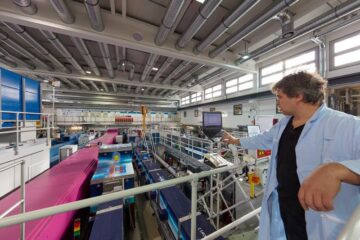Strong Reasons make Strong Actions – Support Structures for Wind Turbines

Wind energy is developing itself to one of the world’s largest source of renewable energy. However, the erection wind energy converters (WEC) not only concerns efficient, environmental friendly generation of electricity.
First and foremost, is the design of safe substructures for the ever greater dimensioned wind turbines, which must be able to withstand the static burdens of storms as well as those offshore turbines which must withstand the heavy swells. The increasing dimensions of WECs and their development, right up to offshore operations, present the experts with new challenges in reference to the design of the support structures.
The 2-Day Technical Conference taking place on the 17th and 18th of February 2009 in the Haus der Technik in Essen, will be moderated by Prof. Dr. Peter Schaumann from the Institute for Steel Construction of the Leibniz Universität Hannover. The conference will lend knowledgeable insight to various types of construction, Foundation Soil Analyses and Structural Design. Special topics will include shell buckling, fatigue detection and constructive details of the connections.
The participants addressed are postgraduate engineers with previous knowledge in structural design. After attending the technical conference, the participants will have gained the essential basics of on and offshore-WEC design including steel tubular towers, lattice towers or prestressed concrete tower as well as their foundations.
For more information, please contact Haus der Technik – Ms. Sabine Gebauer
(Tel.: +49 (0)201/1803-344; Fax: +49 (0)201/1803-346) or under
www.my-windenergy.com – http://www.hdt-essen.de/htd/veranstaltungen/W-H010-02-213-9.html
Media Contact
Weitere Informationen:
http://www.my-windenergy.com http://www.hdt-essen.de/htd/veranstaltungen/W-H010-02-213-9.htmlAlle Nachrichten aus der Kategorie: Veranstaltungsnachrichten
Neueste Beiträge

Bakterien für klimaneutrale Chemikalien der Zukunft
Forschende an der ETH Zürich haben Bakterien im Labor so herangezüchtet, dass sie Methanol effizient verwerten können. Jetzt lässt sich der Stoffwechsel dieser Bakterien anzapfen, um wertvolle Produkte herzustellen, die…

Batterien: Heute die Materialien von morgen modellieren
Welche Faktoren bestimmen, wie schnell sich eine Batterie laden lässt? Dieser und weiteren Fragen gehen Forschende am Karlsruher Institut für Technologie (KIT) mit computergestützten Simulationen nach. Mikrostrukturmodelle tragen dazu bei,…

Porosität von Sedimentgestein mit Neutronen untersucht
Forschung am FRM II zu geologischen Lagerstätten. Dauerhafte unterirdische Lagerung von CO2 Poren so klein wie Bakterien Porenmessung mit Neutronen auf den Nanometer genau Ob Sedimentgesteine fossile Kohlenwasserstoffe speichern können…





















